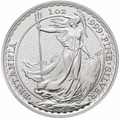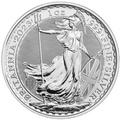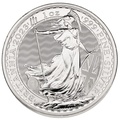British silver coins
Silver has been used for coinage since the Roman denarius and was introduced into Britain during the coin reforms of Charlemagne. As a lower price alternative to gold, silver has remained a popular part of Britain’s coinage to this day, with silver bullion and proof coins still highly sought after. With more than millennia of history however, British silver coins are numerous, with lots of denominations minted over the years. Read more about the various
UK coins,
including silver coins.
Silver content of British coins
The silver content of British coins varies at certain periods in history, but did typically stick to a few specified purities. The most common silver content used for British coins would be Sterling silver. During the twelfth century, Henry II introduced the Sterling silver standard of 925 fineness – 92.5% of the coin being silver and the remainder made up of copper.
Silver coins were progressively debased up to Henry VIII’s reign, meaning the silver content was reduced for a less pure coin. Eventually the silver content reached as low as one-third silver, but his son Edward VI reinstated the Sterling standard, and this would continue to be adhered to until 1920.
Following the First World War and the resulting global economic depression, silver content in British coins was reduced to 50% due to cost and supply shortages. The period was short-lived ( debased silver coins being minted from 1920–1946) and silver coins were eliminated from circulating currency altogether in 1947.
Modern bullion coins reintroduced silver to British coins however, and have become an increasingly popular way to invest in the precious metal. The silver content in modern British silver coins is fine silver - using 999 (99.9% pure silver).
Old British silver coins
A large variety of silver coin denominations have been produced over Britain’s long history and include crowns, shillings, florins, pennies, twopence, fourpence and sixpence.
A common misconception is that the shared design work between the gold Sovereign and the silver Crown means the latter is actually a silver Sovereign. Unfortunately, there is no such coin, but the silver Crown is still a desirable collector’s item and a piece of British coin history.
Due to the age and limited numbers of coins still available silver coins of any purity can be immensely collectible and fetch impressive prices.
Commemorative British silver coins
Since its removal from currency, and decimalisation of the Pound Sterling, silver has been used for a number of bullion, proof, and commemorative coins produced by mints across the world.
‘Proof’ and ‘Brilliant Uncirculated’ coins are typically of the highest quality and are produced in limited numbers. This generally increases their value above the metal content as they are sought after items. The bullion coins are mass produced at a lower quality finish, but it is important to note they still contain the same quantity of silver and on a pure metal value are the same as proof and brilliant uncirculated coins.
The Royal Mint in the UK produces a number of such coins most years including the Britannia, Tudor Beasts and Myths & Legends Series. To view our full range of silver coins, click here.
- How To Buy Gold
- How to Buy?
- Payment Options
- Delivery Options
- Gold Storage
- Storage at Brink's
- Gold Investment Guide
- Why buy gold?
- Is gold a good investment?
- Why physical gold?
- Best time to buy gold?
- Gold bars vs coins?
- Gold vs Silver
- Gold - Silver Ratio explained
- VAT on bullion
- CGT on bullion
- Legal tender coins
- Top 5 Gold Investments
- Top 5 Silver Investments
- Gold vs ISAs
- Gold vs Buy-to-Let
- Gold vs FTSE 100
- Gold vs Bitcoin
- Where to buy gold?
- Why buy from us?
- Where to sell gold?
- Coin Shops
- Gold Price Forecasts
- Top 10 Gold Producers
- Top 10 Gold Reserves
- Gold Britannia vs Sovereign
- Britannia coin designs
- Sovereign coin designs
- Sovereign Mintages
- Sovereign mint marks
- British coin specs
- What is a proof coin?
- Royal Mint bullion
- The Queen's Beasts
- Royal Mint Lunar Coins
- Bullion Refiners
- British coin mints
- Krugerrands
- Gold Tola - India & Pakistan
- Bullion Index










